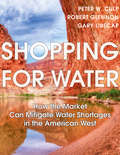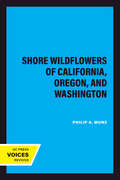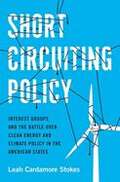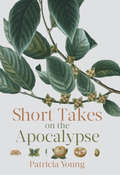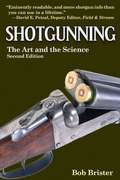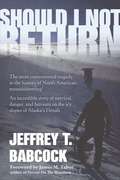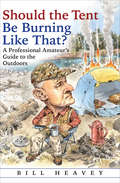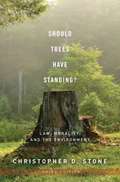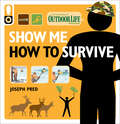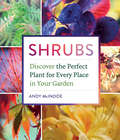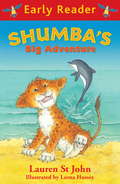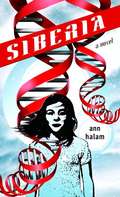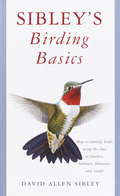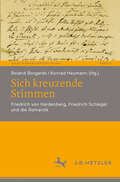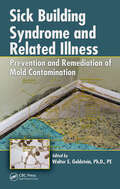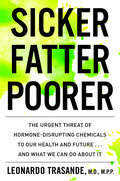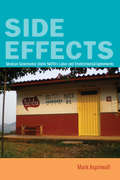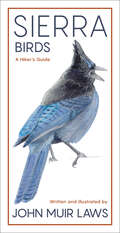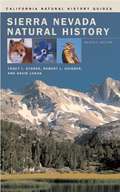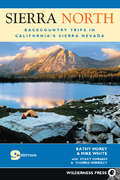- Table View
- List View
Shopping for Water
by Gary Libecap Peter Culp Robert GlennonThe American West has a long tradition of conflict over water. But after fifteen years of drought across the region, it is no longer simply conflict: it is crisis. In the face of unprecedented declines in reservoir storage and groundwater reserves throughout the West, Shopping for Water focuses on a set of policies that could contribute to a lasting solution: using market forces to facilitate the movemof water resources and to mitigate the risk of water shortages. Shopping for Water begins by reviewing key dimensions of this problem: the challenges of population and economic growth, the environmental stresses from overuse of common water resources, the risk of increasing water-supply volatility, and the historical disjunction that has developed between and among rural and urban water users regarding the amount we consume and the price we pay for water. The authors then turn to five proposals to encourage the broader establishmand use of market institutions to encourage reallocation of water resources and to provide new tools for risk mitigation. Each of the five proposals offers a means of building resilience into our water managemsystems.
Shore Chronicles: Diaries and Travelers' Tales from the Jersey Shore, 1764-1955
by Margaret Thomas BuchholzThis anthology gathers a wide assortment of articles, letters, and journal entries all related to life along the New Jersey shore. Included are pieces by such well-known writers as Robert Louis Stevenson, Walt Whitman, and Stephen Crane, and ordinary vacationers. Arranged chronologically, the writings trace the long history of the shore as a lure to visitors, and the changes that intensive human use have brought about.
Shore Wildflowers of California, Oregon, and Washington: Revised Edition (California Natural History Guides #67)
by Philip A. MunzThis title is part of UC Press's Voices Revived program, which commemorates University of California Press’s mission to seek out and cultivate the brightest minds and give them voice, reach, and impact. Drawing on a backlist dating to 1893, Voices Revived makes high-quality, peer-reviewed scholarship accessible once again using print-on-demand technology. This title was originally published in 1964.
Short Circuiting Policy: Interest Groups and the Battle Over Clean Energy Climate Policy in the American States
by Leah Cardamore StokesIn 1999, Texas passed a landmark clean energy law, beginning a groundswell of new policies that promised to make the US a world leader in renewable energy. <p><p> As Leah Stokes shows in Short Circuiting Policy, however, that policy did not lead to momentum in Texas, which failed to implement its solar laws or clean up its electricity system. Examining clean energy laws in Texas, Kansas, Arizona, and Ohio over a thirty-year time frame, Stokes argues that organized combat between advocate and opponent interest groups is central to explaining why states are not on track to address the climate crisis. She tells the political history of our energy institutions, explaining how fossil fuel companies and electric utilities have promoted climate denial and delay. Stokes further explains the limits of policy feedback theory, showing the ways that interest groups drive retrenchment through lobbying, public opinion, political parties and the courts. <p><p> More than a history of renewable energy policy in modern America, Short Circuiting Policy offers a bold new argument about how the policy process works, and why seeming victories can turn into losses when the opposition has enough resources to roll back laws.
Short Takes on the Apocalypse
by Patricia YoungThe poems in this collection originated as a response to Elmore Leonard's "Ten Rules of Writing" and metamorphosed into poetic responses to quotations and epigraphs on a variety of subjects.
Shotgunning: The Art and the Science
by Bob BristerThe classic shotgun reference from one of the top experts in the field.In this near-legendary handbook, respected firearms expert Bob Brister offers advice, instructions, and solutions to every situation a shotgunner might face, making Shotgunning a guide from which both seasoned veterans and novice shooters will benefit. Based on years of tests, meticulous study of data, and a lifetime of insider expertise, this book will help any shooter make every shot count.A veritable encyclopedia of the shotgun for the modern shooter and outdoorsman, Shotgunning details the selection of guns, loads, and chokes; required leads (translated into "bird lengths” for easier shooting recognition); shot velocity and penetration; the effects of recoil on the shooter; wind and temperature effects on shotshells; and much more. Data analysis puts blithely held truths to the test. Myths are debunked, and Brister’s conclusions are supported with hundreds of photographs, lending Shotgunning an authority that many recent, worthwhile books on the subject cannot claim.Brister brightly and boldly presents his readers with the science of shotgunning, but he never forgets the art that makes shooting a sport. Shotgunning is an elegant and educational mélange-a unique and invaluable guidebook that any shotgunner must own.Skyhorse Publishing is proud to publish a broad range of books for hunters and firearms enthusiasts. We publish books about shotguns, rifles, handguns, target shooting, gun collecting, self-defense, archery, ammunition, knives, gunsmithing, gun repair, and wilderness survival. We publish books on deer hunting, big game hunting, small game hunting, wing shooting, turkey hunting, deer stands, duck blinds, bowhunting, wing shooting, hunting dogs, and more. While not every title we publish becomes a New York Times bestseller or a national bestseller, we are committed to publishing books on subjects that are sometimes overlooked by other publishers and to authors whose work might not otherwise find a home.
Should I Not Return: The most controversial tragedy in the history of North American mountaineering!
by Jeffrey BabcockShould I Not Return is the story of a young east coast climber, who joins his brother in Alaska to climb Mount McKinley. What set their climb apart from those before it, and even those afterward, was a disaster of such magnitude that it became know as North America's worst mountaineering tragedy. Prior to July of 1967 only four men had ever perished on Denali, and then, in one fell swoop, Denali--like Melville s, Great White Whale, Moby Dick--indiscriminately took the lives of seven men. The brothers survive one danger after another: a terrible train accident, a near drowning in the McKinley River, an encounter with a large grizzly, a 60 foot plunge into a gaping crevasse, swept away by a massive avalanche, and finally a climactic escape from the terror of 100 mph winds while descending from the summit. Should I Not Return is a one of a kind cliffhanger packed with danger, survival under the worst conditions, and heroism on the Last Frontier s most treasured trophy--the icy slopes of Denali, North America s tallest mountain--Mount McKinley.
Should the Tent Be Burning Like That?: A Professional Amateur's Guide to the Outdoors (Books That Changed the World)
by Bill HeaveyThe popular Field and Stream columnist shares the many joys—and even more numerous pains—of his hilarious outdoor antics in this essay collection. For more than twenty years, Bill Heavey—a three-time National Magazine Award finalist—has staked a claim as one of America&’s best sportswriters. In his Field & Stream column, &“A Sportsman&’s Life,&” and feature stories for that magazine and others, he takes readers across the country and beyond to experience his triumphs and failures as a suburban dad who happens to love hunting and fishing. This new collection gathers a wide range of Heavey&’s best work. He nearly drowns attempting to fish the pond inside the cloverleaf off an interstate highway four miles from the White House. He almost destroys a houseboat on a river in Florida and bravely buys pantyhose to save his legs on a long horseback ride into the Wyoming mountains. Whether he&’s hunting mule deer in Montana, draining cash on an overpriced pistol, or ruminating on the joys and agonies of outdoor gear, Heavey&’s tales are odes to the notion that enthusiasm is more important than skill. &“Readers don&’t have to hunt or fish to appreciate Mr. Heavey&’s essays, which . . . are more complicated than they first appear. The title of his book evokes the knee-slapping comedy of the campfire, a promise that his peculiar brand of farce frequently fulfills. But he also displays a gift for the sublime.&” —Wall Street Journal
Should trees have Standing: Law, Morality, and the Environment,
by Christopher D. StoneIn this collection of essays, the author argues that natural objects, such as trees, should have legal rights through the appointment of guardians designated to protect them. It covers such areas as: agriculture and the environment: can the oceans be harbored; establishing a guardian for future generations; reflections on sustainable development; how to heal the planet; environmentalism, is it dead.
Show Me How to Survive
by The Editors of Outdoor Life Joseph PredA fully illustrated, step-by-step survival guide that shows everything from extreme wilderness-conquering tactics to lifesaving first aid.Stave off hyena attacks, light a fire with chocolate, and outride an avalanche with How to Survive: The Handbook for the Modern Hero. Outdoors enthusiasts and safety gurus alike need look no further than this practical, hands-on guidebook that will help you conquer any situation with cheeky humor and simplified instructions, including tutorials on how to:- Survive a shipwreck- Spot and treat a concussion- Prepare for social collapse- Catch backyard game- Navigate out of a swamp- Use a fire plank- Drive on black ice- Catch a fish bare-handed- Fill sandbags correctly- Wrap a sling- Spike an assailant- Outride an avalanche- Perform lifesaving first aidPresented in the bold new visual style of the award-winning Show Me How series, drawing on the best of information technology and graphic-novel communication, this is an innovative reference book that can and will be enjoyed as a work of art and as a quirky, thoughtful gift.From basic first aid to battling wild animals, 175 things every modern-day survivor needs to know—one step at a time. Packed with useful hands-on tutorials, How to Survive is a real-life resource that can turn anyone into an expert in any situation.
Shrubs: Discover the Perfect Plant for Every Place in Your Garden
by Andy McIndoeA Shrub for Every Situation Shrubs are the perfect plant—they are low-maintenance, there is a variety for nearly every need, and they are widely available at garden centers and nurseries. In his new book Shrubs, Andy McIndoe—one of the world’s foremost woody plant experts—offers the information and advice needed to pick the right shrub for every site and condition. Shrubs includes plant suggestions for challenging growing conditions and restricted planting spaces, along with shrubs chosen for their desirable characteristics, including hardiness in shade, difficult soil, and harsh conditions. Every plant profile includes complete growing information, color photographs, and recommended companion plants. With this helpful guide in hand, it’s easier than ever to decide which shrubs to add to your home garden.
Shumba's Big Adventure
by Lauren St JohnEarly Readers are stepping stones from picture books to reading books. A blue Early Reader is perfect for sharing and reading together. A red Early Reader is the next step on your reading journey.Shumba is the naughtiest lion cub in the whole of Africa. When he sneaks off one night to go exploring, he finds himself on a boat going all the way to England with gorillas, snakes, monkeys, zebras and parrots. And that's just the start of his adventure! A heartwarming Early Reader story from the author of the White Giraffe quartet, which brings Africa and its animals to life for the youngest readers.
Shumba's Big Adventure (Early Reader)
by Lauren St JohnEarly Readers are stepping stones from picture books to reading books. A blue Early Reader is perfect for sharing and reading together. A red Early Reader is the next step on your reading journey.Shumba is the naughtiest lion cub in the whole of Africa. When he sneaks off one night to go exploring, he finds himself on a boat going all the way to England with gorillas, snakes, monkeys, zebras and parrots. And that's just the start of his adventure! A heartwarming Early Reader story from the author of the White Giraffe quartet, which brings Africa and its animals to life for the youngest readers.
Si encuentras una piedra (¡Arriba la Lectura! Read Aloud Module 2 #3)
by Peggy Christian Barbara LemberNIMAC-sourced textbook
Siamese and Other Short-haired Cats (World Book's Animals of the World)
by Karen IngebretsenTopics include what a Siamese is, what they look like and how to care for a pet cat.
Siberia: A Novel
by Ann HalamWhen Sloe was tiny, her Papa disappeared and she and her mama went to live in a prison camp in the snowy north, in a time and place when there are no more wild animals. Mama's crime: teaching science, and her dedication to the hope that the lost animal species can be reborn. To Sloe, Mama's secret work is magic, as enchanting as Mama's tales of a bright city across the ice where they will be free. Years later, Sloe is sent to a prison school, and Mama disappears. At thirteen, Sloe escapes, pursued by a mysterious man. With only hope to keep her going, Sloe sets out on a solitary 1000 mile journey. But she is not truly alone for Mama left Sloe a gift: the seeds of five missing species and the knowledge to bring them to life.
Sibley's Birding Basics
by David Allen Sibley"I wrote and illustrated this book to help every inquisitive birder, from novice to expert. Whether you can identify six birds or six hundred, you'll be a better birder if you have a grounding in the real nuts and bolts of what birds look like, and your skills will be even sharper if you know exactly what to look for and how to record what you see." --David Allen Sibley The Sibley Guide to Birds and The Sibley Guide to Bird Life and Behavior are both universally acclaimed as the new standard source of species information. And now David Sibley, America's premier birder and best-known bird artist, takes a new direction; in Sibley's Birding Basics he is concerned not so much with species as with the general characteristics that influence the appearance of all birds and thus give us the clues to their identity.To create this guide, David Sibley thought through all the skills that enable him to identify a bird in the few instants it is visible to him. Now he shares that information, integrating an explanation of the identification process with many painted and drawn images of details (such as a feather) or concepts. Birding Basics begins by reviewing how one can get started as a birder: the equipment necessary, where and when to go birding, and perhaps most important, the essential things to look for when birds appear in the field. Using many illustrations, David Sibley reviews all the basic concepts of bird identification and then describes the variations (of shape, size, and color) that can change the appearance of a bird over time or in different settings. And he issues a warning about "illusions and other pitfalls"--and advice on avoiding them. The second part of the book, also plentifully illustrated, deals with another set of clues, the major aspects of avian life that differ from species to species: feathers (color, arrangement, shape, molt), behavior and habitat, and sounds.This scientifically precise, beautifully illustrated volume distills the essence of David Sibley's own experience and skills, providing a solid introduction to "naming" the birds. With Sibley as your guide, when you learn how to interpret what the feathers, the anatomical structure, the sounds of a bird tell you--when you know the clues that show you why there's no such thing as "just a duck"--birding will be more fun, and more meaningful. An essential addition to the Sibley shelf!From the Trade Paperback edition.
Sich kreuzende Stimmen: Friedrich von Hardenberg, Friedrich Schlegel und die Romantik (Neue Romantikforschung #8)
by Roland Borgards Konrad HeumannFriedrich von Hardenberg und Friedrich Schlegel verdanken wir zwei der berühmtesten Denkfiguren der Romantik: die ‚blaue Blume‘ und die ‚progressive Universalpoesie‘. Ein wichtiger Quellpunkt solcher Denkfiguren ist der Briefwechsel zwischen Hardenberg und Schlegel, der 2022 anlässlich ihres 250. Doppelgeburtstages in einer Ausstellungreihe im Deutschen Romantik-Museum, Frankfurt am Main, zu sehen war. Begleitend zur Ausstellung hat sich eine Ringvorlesung des Instituts für Deutsche Literatur, Frankfurt, mit dem Anteil Hardenbergs und Schlegels an der frühromantischen Theoriebildung auseinandergesetzt. Der vorliegende Band dokumentiert die Beiträge dieser Ringvorlesung. Der Briefwechsel zwischen Hardenberg und Schlegel bildet dabei den Ausgangspunkt der Überlegungen. Im Zentrum stehen dabei zunächst der Brief als Medium des Symphilosophierens sowie Religion und Republik als zwei zentrale Themen des Briefwechsel. Dann aber weist der Band auch über die Fragen, die die beiden Frühromantiker im brieflichen Austausch entwickeln, hinaus. Der Akzent liegt dabei auf Themenfeldern, die in der Forschung bisher weniger intensiv aufgegriffen wurde: die Idylle, die Ökologie und die Chemie.
Sick Building Syndrome and Related Illness: Prevention and Remediation of Mold Contamination
by Walter E. GoldsteinSmall but mighty, ranging from 3 to 100 microns in size, miniscule mold organisms can cause big problems. A seemingly minor water leak behind a wall, unnoticed until the sinister color of mold is evident, can wreak havoc and cause a financial nightmare. A practical primer, Sick Building Syndrome and Related Illness: Prevention and Remediation of Mo
Sicker, Fatter, Poorer: The Urgent Threat of Hormone-Disrupting Chemicals to Our Health and Future . . . and What We Can Do About It
by Leonardo TrasandeA leading voice in public health policy and top environmental medicine scientist reveals the alarming truth about how hormone-disrupting chemicals are affecting our daily lives—and what we can do to protect ourselves and fight back. Lurking in our homes, hiding in our offices, and polluting the air we breathe is something sinister. Something we’ve turned a blind eye to for far too long. Dr. Leonardo Trasande, a pediatrician, professor, and world-renowned researcher, tells the story of how our everyday surroundings are making us sicker, fatter, and poorer. Dr. Trasande exposes the chemicals that disrupt our hormonal systems and damage our health in irreparable ways. He shows us where these chemicals hide—in our homes, our schools, at work, in our food, and countless other places we can’t control—as well as the workings of policy that protects the continued use of these chemicals in our lives. Drawing on extensive research and expertise, he outlines dramatic studies and emerging evidence about the rapid increases in neurodevelopmental, metabolic, reproductive, and immunological diseases directly related to the hundreds of thousands of chemicals that we are exposed to every day. Unfortunately, nowhere is safe. But, thanks to Dr. Trasande’s work on the topic, and his commitment to effecting change, this book can help. Through a blend of narrative, scientific detective work, and concrete information about the connections between chemicals and disease, he shows us what we can do to protect ourselves and our families in the short-term, and how we can help bring the change we deserve.
Side Effects: Mexican Governance Under NAFTA's Labor and Environmental Agreements
by Mark AspinwallThis is a story about governance in Mexico after the labor and environmental accords-called "side agreements"-that accompanied the NAFTA treaty went into effect. These side agreements required member states to uphold and enforce their labor and environmental laws; though never codified, it was widely accepted that Mexico, in particular, had a problem with law enforcement. Side Effectsexplores how differences in institutional design (of the side agreements) and domestic capacity (between the labor and environment sectors) influenced norm socialization in Mexico. It argues that the acceptance of rule-of-law norms in environmental governance can be attributed to participating institutions' independence from national control, their willingness to give citizens access, and the professionalization and technical capacity of domestic bureaucrats and civil society actors. Changes in labor governance have been hampered by union confederations, longstanding corruption, and a closed opportunity structure. Going beyond a simple accounting exercise of resources devoted to enforcing the law, this book comes to grips with how best to strengthen local capacity and promote pro-norm behavior-advances essential to the task of development and democratization.
Sierra Birds: A Hiker's Guide
by John LawsOver 35,000 copies sold! As a naturalist managing the field studies program at the California Academy of Sciences, John Muir Laws noticed that novice birders often distinguish birds by color and size rather than species. This inspired him to create Sierra Birds: A Hiker's Guide, a unique book that assumes no prior birding knowledge on the part of the reader. Color-coded keys eliminate the time-consuming frustration of thumbing randomly through a guide, and a cross-index is also included for more advanced birders. All this in a format that is simply organized, lightweight, and small enough to tuck inside a pocket. A first-rate naturalist, Laws is also an accomplished artist. His illustrations are lively, colorful, and accurate, and drawn to represent species in the manner in which one generally sees them in the field.
Sierra Birds: A Hiker's Guide
by John Muir LawsThe beginner’s birding book that covers species found in the Sierra Nevada—from the author of The Law’s Guide to Nature Drawing and Journaling.As a naturalist managing the field studies program at the California Academy of Sciences, John Muir Laws noticed that novice birders often distinguish birds by color and size rather than species. This inspired him to create Sierra Birds: A Hiker’s Guide, a unique book that assumes no prior birding knowledge on the part of the reader. Color-coded keys eliminate the time-consuming frustration of thumbing randomly through a guide, and a cross-index is also included for more advanced birders. All this in a format that is simply organized and perfect to read on a smartphone or tablet. A first-rate naturalist, Laws is also an accomplished artist. His illustrations are lively, colorful, and accurate, and drawn to represent species in the manner in which one generally sees them in the field.Praise for John Muir Laws“For those of us who live in California, there are few resources that top the books by John Muir Laws. His Field Guide to the Sierra Nevada and his Pocket Guide to the San Francisco Bay Area combine beautiful illustrations with exacting biological information on birds, beasts, and plants.” —Sierra Magazine
Sierra Nevada Natural History (California Natural History Guide #73)
by Tom Taylor Bill Nelson Tracy I. Storer Robert L. Usinger David Lukas Phyllis M. Faber Peter Gaede John Gamel Bruce M. Pavlik Christopher Rogers<p>The magnificent and much-loved Sierra Nevada, called the "Range of Light" by John Muir, is the dominant feature on the California landscape. First published forty years ago, this handbook has become an enduring natural history classic, used by thousands to learn more about virtually every aspect of this spectacular mountain range―from its superb flora and fauna to its rugged topography. <p>Comprehensive yet concise and portable, the book describes hundreds of species: trees and shrubs, flowering plants and ferns, fungi and lichens, insects and fish, amphibians and reptiles, and birds and mammals. Now completely updated and revised, it will continue to be the essential guide to the Sierra Nevada for a new generation of hikers, campers, tourists, naturalists, students, and teachers―everyone who wants to know more about this unique and beautiful mountain range. </p>
Sierra North
by Mike White Thomas Winnett Stacey Corless Kathy MoreyNow in its 9th edition, the completely updated and revised Sierra North showcases new trips and old favorites in regions such as Desolation Wilderness, Emigrant Wilderness, the proposed Castle Peak Wilderness, and the world-famous Yosemite National Park.
